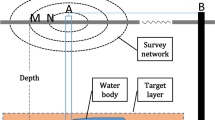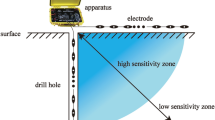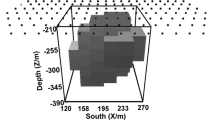Abstract
Borehole-to-surface electrical imaging (BSEI) uses a line source and a point source to generate a stable electric field in the ground. In order to study the surface potential of anomalies, three-dimensional forward modeling of point and line sources was conducted by using the finite-difference method and the incomplete Cholesky conjugate gradient (ICCG) method. Then, the damping least square method was used in the 3D inversion of the formation resistivity data. Several geological models were considered in the forward modeling and inversion. The forward modeling results suggest that the potentials generated by the two sources have different surface signatures. The inversion data suggest that the low-resistivity anomaly is outlined better than the high-resistivity anomaly. Moreover, when the point source is under the anomaly, the resistivity anomaly boundaries are better outlined than when using a line source.
Similar content being viewed by others
References
Beasley, C. W., and Ward, S. H., 1986, Tree-dimensional mise-a-la-masse modeling applied to mapping fracture zones: Geophysics, 51(1), 98–113.
Bevc, D., and Morrison, H. F., 1991, Borehole-to-surface electrical resistivity monitoring of salt water injection experiment: Geophysics, 56(6), 769–777.
Chen, D. P., 2009, 3D FEM forward modeling research of borehole-to-surface DC method drived by the arbitrary linear current source: Msc Thesis, Central South University, Hunan.
Chen, Y. X., 2012, Three-dimensional FEM numerical simulation of borehole-ground potential with gradient current source: Msc Thesis, Central South University, Hunan.
Dai, Q. W., Hou, Z. C., and Wang, H. H., 2013, Analysis of anomaly of Borehole-to-surface electrical method by 2.5D finite element numerical simulation: Geophysical Computing Technology, 35(4), 458–462.
David, P., Carlos, T. V., and Zhang, Z. Y., 2008, Sensitivity study of borehole-to-surface and crosswell electromagnetic measurements acquired with energized steel casing to water displacement in hydrocarbonbearing layers: Geophysics, 73(6), 261–268.
Dey, A., and Morrison, H. F., 1979, Resistivity modeling for arbitrarily shaped two-dimensional structures: Geophysical Prospecting, 27(1), 106–136.
Du, L. Z., Jiang, X. M., Qu, J. W., et al., 2013, Experimental study on abnormal electric field distribution of surfaceborehole electrical method: Global Geology, 3(32), 558–589.
Gu, J. W., Li, F. J., Liu, Y., et al., 2015, Establishing and solving of a one-dimensional well-ground potential model: Journal of China University of Petroleum, 39(6), 100–102.
Ho, T. L., 2009, 3-D inversion of borehole-to-surface electrical data using a back-propagation neural network: Journal of Applied Geophysics, 68(4), 489–499.
LeMasne, D., and Poirmeur, C., 1988, Three-dimensional model results for an electrical hole-to-surface method: Application to the interpretation of a filed survey: Geophysics, 53(1), 85–103.
Li, Y. G., and Spitzer, K., 2002, Tree-dimensional DC resistivity forward modeling using finite elements in comparison with finite-difference solutions: Geophysics Journal International, 151(3), 924–934.
Li, Y. G., and Spitzer, K., 2005, Finite element resistivity modeling for three-dimensional structures with arbitrary anisotropy: Physics of the Earth and Planetary Interiors, 150(1-3), 15–27.
Lian, J., 2007, Research on forward modeling and inversion of vertical line source borehole-ground DC method: Msc Thesis, China University of Geosciences (Beijing), Beijing.
Liu, H. F., Chen, D. P., Dai, Q. W., et al., 2011, 3D FEM modeling of borehole-surface potential with line current source in semi-underground space of continuous variation of conductivity: Journal of Guilin University of Technology, 31(1), 29–38.
Loke, M. H., and Barker, R. D., 1995, Least-squares deconvolution of apparent resistivity pseudosections: Geophysics, 60(6), 1682–1690.
Lorenzo, D. C., Maria, T. P., Maria, C. C., et al., 2013, Characterization of dismissed landfill via electrical resistivity tomography and mise-a-la-masse method: Journal of Applied Geophysics, 98, 1–10.
Mizunaga, H., and Ushijima, K., 1991, Three-Dimensional numerical modeling for the mise-a-la-masse method: Geophysical Exploration (Butsurib-Tansa), 44(4), 215–226.
Nimmer, R. E., and Osiensky, J. L., 2002, Using mise-a-lamasse to delineate the migration of conductive tracer in partially saturated basalt: Environmental Geosciences, 9(2), 8–87.
Perri, M. T., Cassiani, G., Gervasio, I., et al., 2012, A saline tracer test monitored via both surface and cross-borehole electrical resistivity tomography: comparison of timelapse results: Journal of Applied Geophysics, 79, 6–16.
Pridmore, D. F., Hohmann, G. W., Ward, S. H., et al., 1981, An investigation of finite-element modeling for electrical and electromagnetic data in three dimensions: Geophysics, 46(7), 1009–1024.
Scriba, H., 1981, Computation of the electrical potential in three dimension structures: Geophysical Prospecting, 29(5), 790–802.
Spitzer, K., 1995, A 3-D finite-difference algorithm for DC resistivity modeling using conjugate gradient methods: Geophysical Journal International, 123(3), 903–914.
Su, B. Y., Fujimitsu, Y., Xu, J. L., et al., 2012, A model study of residual oil distribution jointly using crosswell and borehole-surface electric potential methods: Applied Geophysics, 9(1), 19–26.
Surendra, R. P., 2004, Tracing groundwater flow by misea-la-masse measurement of injected saltwater: Journal of Environmental and Engineering Geophysics, 9(3), 155–165.
Tan, H. Q., Shen, J. S., Zhou, C., et al., 2004, Borehole-tosurface electrical imaging technique and its application to residual oil distribution analysis of the eighth section in Gudong Oilfield: Journal of the University of Petroleum, China, 28(2), 32–37.
Thomas, H., Andreas, K., and Frederic, N., 2015, Covariance-constrained difference inversion of timelapse electrical resistivity tomography data: Geophysics, 81(5), 311–322.
Tsili, W., Stodt, J. A., Stierman, D. J., et al., 1991, Mapping hydraulic fracture using a borehole-to-surface electrical resistivity method: Geoexploration, 28(3-4), 349–369.
Tsourlos, P., Ogilvy, R., Papazachos, C., et al., 2011, Measurement and inversion schemes for single borehole–to-surface electrical resistivity tomography surveys: Geophysics and Engineering, 8(4), 487–497.
Tsourlos, P., Papadopoulos, N., Papazachos, C., et al., 2014, Efficient 2D inversion of long ERT section: Journal of Applied Geophysics, 105, 213–224.
Wang, Z. G., He, Z. X., Wei, W. B., et al., 2005, 3-D physical model experiments of well-to-ground electrical survey: Oil Geophysical Prospecting, 40(5), 595–597.
Wu, X. P., 2003, A 3-D finite-element algorithm for DC resistivity modeling using the shifted incomplete Cholesky conjugate gradient method: Geophysical Journal International, 154(3), 947–956.
Wu, X. P., and Xu, G. M., 2000, Study on 3-D resistivity inversion using conjugate gradient method: Chinese Journal of Geophysics, 43(3), 421–426.
Wu, X. P., Xu, G. M., and Li, S. C., 1998, The calculation of Three-dimensional geoelectric field of point source by incomplete Cholesky conjugate gradient method: Acta Geophysica Sinica, 41(6), 848–855.
Zhang, Y. Y., Liu, D. J., Ai, Q. H., et al., 2014, 3D modeling and inversion of the electrical resistivity tomography using steel cased boreholes as long electrodes: Journal of Applied Geophysics, 109, 292–300.
Zhang, Y., 2009, The forward modeling of Threedimensional borehole-to-surface logging technology: MSc thesis, Ocean University of China, Qingdao.
Zhou, X. R., Zhong, B. S., Jiang, Y. L., et al., 1986: Numerical simulation technology of electrical prospecting, Sichuan Science and Technology Press, Chengdu, 163–239.
Zhou, Y. Q., 2015, 2.5-D modeling and inversion of the surface to hole resistivity imaging research and application: Msc Thesis, East China Institute of Technology, Jiangxi.
Author information
Authors and Affiliations
Corresponding author
Additional information
This work was sponsored by the National Major Project (No. 2016ZX05014-001), the National Natural Science Foundation of China (No. 41172130 and U1403191), and the Fundamental Research Funds for the Central Universities (No. 2-9-2015-209).
Bai Ze, a PhD Candidate of the School of Geophysics and Information Technology, China University of Geosciences (Beijing). His research interests are in electrical prospecting and well logging.
Rights and permissions
About this article
Cite this article
Bai, Z., Tan, MJ. & Zhang, FL. Three-dimensional forward modeling and inversion of borehole-to-surface electrical imaging with different power sources. Appl. Geophys. 13, 437–448 (2016). https://doi.org/10.1007/s11770-016-0575-8
Received:
Revised:
Published:
Issue Date:
DOI: https://doi.org/10.1007/s11770-016-0575-8




